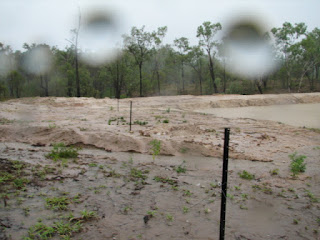I've been involved with milking a house cow my entire life. I remember waking up most mornings as a child, to the sound of the milk separator. That's the machine that separates the milk from the cream. My father grew up on a dairy in the days when the cows were hand milked. Therefore he naturally had a house cow when he left the family dairy and married my mother. I'm one of eight kids, so having our own cow would've been essential. We grew up with fresh milk, fresh cream and home made butter. I have so many fond memories based around fresh cream - thick and just delicious on anything!
So what do I do with my house cow? Well, I have several as I don't like to be without milk and I also like to separate the milk and eat cream and make butter and make yoghurt and cheese! And if there is a surplus I give it away to friends!
Fetta Cheese
I keep a very close eye on my cows just before they are due to calve. I will never forget one cow I had when I was very new to milking. She had calved and I didn't know for a week. By the time I got her into the yard it was almost too late to save her back two teats. She was so full of milk, the calf was only sucking the front two, which is often the case. I managed, with great difficulty to milk out the back two. They had gone hard and the milk was like water. How she didn't get sick from mastitis I don't know. So Lesson 1 - keep an eye on your cow BEFORE she calves and milk her out each day as the calf usually won't handle all the milk.Once she has calved, it can take a week and sometimes even longer for the milk to clean up. This first milk is colostrum and is a yellowish colour. Sometimes, if the cow has a very large and full udder, the milk can be a bit bloody - this is fine. If it's nice and clean (without blood) I usually freeze some to keep for poddy calves or pigs. When you milk this out, feed it to the chooks or pigs or dogs.
Once the milk is no longer yellow coloured and it looks good enough to keep, you may need to start locking up the calf before milking. The cow I'm currently milking gives me more than 10 litres without locking the calf up, so I don't bother. Usually though, you won't get enough out of a cow while the calf is on 100% of the time. When you want to milk, take the calf away the night before (or morning if you plan to milk in the afternoon).This is called share milking.
When I'm milking and I have plenty of milk, I usually leave a quarter for the calf. If I want all the milk I take it all. The cow will make up some more milk throughout the day, so the calf will still get plenty. If the cow doesn't let her milk down for me, I let the calf out to suck for a minute or so until she lets her milk down, then I just push the calf off and back in the calf pen. For those that are confused about my terminology, "letting the milk down" is a term used when the milk comes more freely (anyone that has breastfed, will know what I mean!) Basically it can be hard work milking if they don't let it down, and when they do, it comes easily (sort of).
I also milk by hand. Some people new to milking use a machine. I've always been told that to use a milking machine you would need at least 4 cows to make the washing up worthwhile. I've never used a machine, but I think I would have to agree. I've been milking by hand for many years, and yes dust and insects etc get into the milk, but I have a good strainer to get it all out! I really enjoy the quiet time of sitting beside the cow and just doing it! I do have to watch for the odd kick, especially if there's sandflies or buffalo fly around. But most of the time, it's peaceful and I can just sit there and plan my day. I very rarely milk more than 4 cows and that would take me about an hour, so I'm not sure how much time a machine would take.
So, my summary:
1. Keep an eye on the cow before she calves to make sure you get her in and milk her out immediately (the second day at the absolute latest!) This will help to prevent mastitis and milk fever.
2. Lock up the calf each night/or day so that you get plenty of milk.
3. If the cow doesn't let her milk down, allow the calf to suck for a minute or so first - and then put the calf away.
4. Leave a quarter for the calf if you don't need the mild. If your need is greater, the calf will be fine as the cow will compensate.
5. Feed the cow a little extra when locking up the calf and then while milking as this will ensure she keeps in good condition. A dairy cow will give EVERYTHING to the calf and will get poor!
6. Enjoy the milk fresh, in yoghurt, cream, butter, cheese, custard!!
























